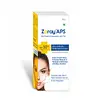What's inside
What's inside
 Key Ingredients
Key Ingredients

 Benefits
Benefits

 Concerns
Concerns

 Ingredients Side-by-side
Ingredients Side-by-side

Water
Skin ConditioningDiethylamino Hydroxybenzoyl Hexyl Benzoate
UV FilterHomosalate
Skin ConditioningDiisopropyl Sebacate
EmollientBis-Ethylhexyloxyphenol Methoxyphenyl Triazine
Skin ConditioningDibutyl Adipate
EmollientPropanediol
SolventEthylhexyl Salicylate
UV AbsorberEthylhexyl Triazone
UV AbsorberGlycerin
HumectantSilica
AbrasiveCI 77891
Cosmetic ColorantSucrose Laurate
EmollientUndecane
EmollientC20-22 Alkyl Phosphate
EmulsifyingSodium Stearoyl Glutamate
CleansingC20-22 Alcohols
Emulsion StabilisingSodium Polyacrylate
AbsorbentTridecane
PerfumingCapryloyl Glycine
CleansingSodium Hydroxide
BufferingSodium Citrate
BufferingCaprylyl Glycol
EmollientEctoin
Skin ConditioningMannitol
HumectantXylitol
HumectantRhamnose
HumectantSodium Lauroyl Glutamate
Lysine
Skin ConditioningMagnesium Chloride
Fructooligosaccharides
HumectantCaprylic/Capric Triglyceride
MaskingTocopherol
AntioxidantHelianthus Annuus Seed Oil
EmollientLaminaria Ochroleuca Extract
Skin ConditioningWater, Diethylamino Hydroxybenzoyl Hexyl Benzoate, Homosalate, Diisopropyl Sebacate, Bis-Ethylhexyloxyphenol Methoxyphenyl Triazine, Dibutyl Adipate, Propanediol, Ethylhexyl Salicylate, Ethylhexyl Triazone, Glycerin, Silica, CI 77891, Sucrose Laurate, Undecane, C20-22 Alkyl Phosphate, Sodium Stearoyl Glutamate, C20-22 Alcohols, Sodium Polyacrylate, Tridecane, Capryloyl Glycine, Sodium Hydroxide, Sodium Citrate, Caprylyl Glycol, Ectoin, Mannitol, Xylitol, Rhamnose, Sodium Lauroyl Glutamate, Lysine, Magnesium Chloride, Fructooligosaccharides, Caprylic/Capric Triglyceride, Tocopherol, Helianthus Annuus Seed Oil, Laminaria Ochroleuca Extract
Cyclopentasiloxane
EmollientZinc Oxide
Cosmetic ColorantPEG-10 Dimethicone
Skin ConditioningDimethicone/Vinyl Dimethicone Crosspolymer
Skin ConditioningHydrogen Dimethicone
Shea Butter Ethyl Esters
EmollientDimethicone
EmollientEctoin
Skin ConditioningGlycerin
HumectantTocopheryl Acetate
AntioxidantPhenoxyethanol
PreservativeButylene Glycol
HumectantPolysilicone-11
Cyclohexasiloxane
EmollientSilica Dimethyl Silylate
EmollientMica
Cosmetic ColorantTriethylene Glycol
MaskingQuaternium-90 Bentonite
Titanium Dioxide
Cosmetic ColorantPolysorbate 40
EmulsifyingIron Oxides
Propylene Carbonate
SolventCyclopentasiloxane, Zinc Oxide, PEG-10 Dimethicone, Dimethicone/Vinyl Dimethicone Crosspolymer, Hydrogen Dimethicone, Shea Butter Ethyl Esters, Dimethicone, Ectoin, Glycerin, Tocopheryl Acetate, Phenoxyethanol, Butylene Glycol, Polysilicone-11, Cyclohexasiloxane, Silica Dimethyl Silylate, Mica, Triethylene Glycol, Quaternium-90 Bentonite, Titanium Dioxide, Polysorbate 40, Iron Oxides, Propylene Carbonate
 Reviews
Reviews

Ingredients Explained
These ingredients are found in both products.
Ingredients higher up in an ingredient list are typically present in a larger amount.
Ectoin is a compound found naturally in some species of bacteria. It can be synthetically created for skincare use.
This ingredient is an osmolyte; Osmolytes help organisms survive osmotic shock (it protects them from extreme conditions). It does this by influencing the properties of biological fluids within cells.
When applied to the skin, ectoin helps bind water molecules to protect our skin. The water forms a sort of armor for the parts of our skin cells, enzymes, proteins, and more.
Besides this, ectoin has many uses in skincare:
A study from 2004 found ectoin to counteract the damage from UV-A exposure at different cell levels. It has also been shown to protect skin against both UV-A, UV-B rays, infrared light, and visible light.
Studies show ectoin to have dual-action pollution protection: first, it protects our skin from further pollution damage. Second, it helps repair damage from pollution.
In fact, ectoin has been shown to help with:
Fun fact: In the EU, ectoin is used in inhalation medication as an anti-pollution ingredient.
Ectoin is a highly stable ingredient. It has a wide pH range of 1-9. Light, oxygen, and temperature do not affect this ingredient.
Learn more about EctoinGlycerin is already naturally found in your skin. It helps moisturize and protect your skin.
A study from 2016 found glycerin to be more effective as a humectant than AHAs and hyaluronic acid.
As a humectant, it helps the skin stay hydrated by pulling moisture to your skin. The low molecular weight of glycerin allows it to pull moisture into the deeper layers of your skin.
Hydrated skin improves your skin barrier; Your skin barrier helps protect against irritants and bacteria.
Glycerin has also been found to have antimicrobial and antiviral properties. Due to these properties, glycerin is often used in wound and burn treatments.
In cosmetics, glycerin is usually derived from plants such as soybean or palm. However, it can also be sourced from animals, such as tallow or animal fat.
This ingredient is organic, colorless, odorless, and non-toxic.
Glycerin is the name for this ingredient in American English. British English uses Glycerol/Glycerine.
Learn more about Glycerin